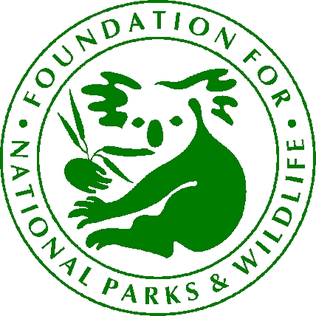
Biriwal Bulga National Park is an Australian national park in New South Wales. It is approximately 45 km north west of Taree and 60 km west of Port Macquarie on the Bulga Plateau.

Conservation in Australia is an issue of state and federal policy. Australia is one of the most biologically diverse countries in the world, with a large portion of species endemic to Australia. Preserving this wealth of biodiversity is important for future generations. 25% of Australia is managed for conservation.

The Foundation for National Parks & Wildlife is an Australian not-for-profit, non-governmental organisation that was incorporated on 29 June 1970. Its purpose is to foster the protection of Australia's native plants, animals and cultural heritage through fundraising for environmental education and conservation projects. Since 1970 the organisation has raised more A$ 45 million for environmental conservation. The foundation was founded as a New South Wales–focused organisation, however in 2000 the foundation's members voted to amend its constitution so that the organisation could expand the scope of its work Australia-wide.

Wildlife rehabilitation is the treatment and care of injured, orphaned, or sick wild animals so that they can be released back to the wild.

Emeritus Professor Harry Frederick Recher RZS (NSW) AM is an Australian ecologist, ornithologist and advocate for conservation.

The Wildlife Preservation Society of Queensland based in Queensland, Australia is a not-for-profit organisation which aims to engage communities to deliver conservation outcomes.
The Southern Oceans Seabird Study Association (SOSSA) is an Australian natural history research and conservation organisation. It is based in Wollongong, New South Wales. It was formally established in 1994 by members of the New South Wales Albatross Study Group Lindsay Smith and Harry Battam to be an umbrella organisation for groups involved with biological research on, and concerned about the environment of, the Southern Ocean. However, its origins go back to the start of long-term banding studies of albatrosses by Doug Gibson and Allan Sefton on the coast of New South Wales in the mid-1950s, with SOSSA continuing one of the longest-running albatross research programs in the world.
Lindsay E. Smith OAM is an Australian naturalist, ornithologist and conservationist notable for his work towards the study and conservation of seabirds, especially albatrosses, along the Illawarra coast of New South Wales.

Nilgiri Wildlife and Environmental Association (NWEA) is a non-governmental organization registered in Tamil Nadu, India. Their objective is to conserve the wildlife, habitat and natural resources of the Nilgiri Hills.

Distinguished Professor David Lindenmayer,, is an Australian scientist and academic. His research focuses on the adoption of nature conservation practices in agricultural production areas, developing ways to improve integration of native forest harvesting and biodiversity conservation, new approaches to enhance biodiversity conservation in plantations, and improved fire management practices in Australia. He specialises in large-scale, long-term research monitoring programs in south-eastern Australia, primarily in forests, reserves, national parks, plantations, and on farm land.

The Dharawal National Park is a protected national park that is located in the Illawarra region of New South Wales, in eastern Australia. The 6,508-hectare (16,080-acre) national park is situated between the Illawarra Range and the Georges River and is approximately 45 kilometres (28 mi) south west of Sydney. There are three entry points to the park: from the east through Darkes Forest; from the north through Wedderburn; and from the south through Appin.

Katherine Belov is an Australian geneticist, professor of comparative genomics in the School of Life and Environmental Sciences and Pro Vice Chancellor of Global Engagement at the University of Sydney. She is head of the Australasian Wildlife Genomics Group and research expert in the area of comparative genomics and immunogenetics, including Tasmanian devils and koalas, two iconic Australian species that are threatened by disease processes. Throughout her career, she has disproved the idea that marsupial immune system is primitive, characterized the South American gray short-tailed opossum's immune genes, participated in the Platypus Genome Project, led research identifying the properties of platypus venom, and identified the cause of the spread of the Tasmanian devil's contagious cancer.
Marsh Charitable Trust, also known as Marsh Christian Trust, is a national charity in the United Kingdom, based in London. It is a registered charity under English law, and was established in 1981 by Brian Marsh, the current Chairman. Marsh was appointed an OBE for services to business and charity in the 2005 New Year Honours.

The Wirrimbirra Sanctuary is a heritage-listed fauna sanctuary, native plant nursery, education centre and flora sanctuary located off the Hume Highway at 1305 Remembrance Drive, in outer south-western Sydney in the settlement of Bargo in the Wollondilly Shire local government area of New South Wales, Australia. It was built in 1962 by the Stead Foundation. The property is owned by the National Trust of Australia. It was added to the New South Wales State Heritage Register on 1 March 2002.

Valerie May Taylor AM is an Australian conservationist, photographer, and filmmaker, and an inaugural member of the diving hall of fame. With her husband Ron Taylor, she made documentaries about sharks, and filmed sequences for films including Jaws (1975).

Koala conservation organisations, programs and government legislation are concerned with the declining population of koalas, a well known Australian marsupial found in gum trees. The Australian government declared the species as endangered by extinction in 2022.
Judy Messer (1933–2023) was an Australian conservationist.













